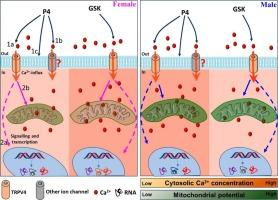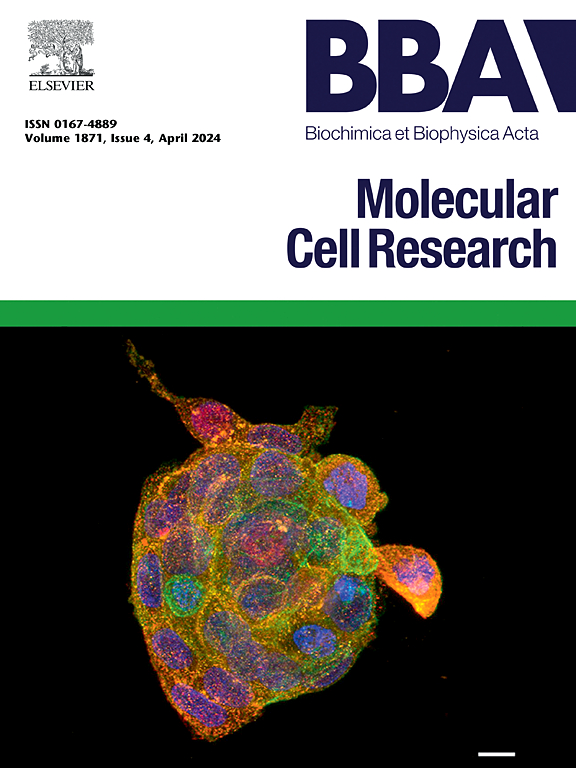TRPV4参与孕激素介导的间充质干细胞功能和生物矿化的两性二态现象。
IF 3.7
2区 生物学
Q1 BIOCHEMISTRY & MOLECULAR BIOLOGY
Biochimica et biophysica acta. Molecular cell research
Pub Date : 2025-09-27
DOI:10.1016/j.bbamcr.2025.120066
引用次数: 0
摘要
女性骨骼疾病的流行与性激素失衡有关,特别是在怀孕和绝经期间。除了调控转录外,最近的报道表明,各种离子通道的参与也可能是一系列类固醇(和类固醇样分子)的分子靶点。男性和女性在类固醇反应上的差异也使我们有必要了解类固醇作用的复杂性。本体外研究在成骨细胞分化过程中(分别为第1天和第12天的早、晚时间点),利用来自雄性和雌性动物的间充质干细胞,在黄体酮(P4)和/或TRPV4调节剂存在的情况下,探讨细胞水平上是否存在TRPV4和P4参与的两性二态性。进行了不同的亚细胞参数,如细胞质Ca2+,线粒体电位,细胞质和线粒体ros和功能分析,如生物矿化(BM)。上述结果表明,P4对TRPV4的调节具有短期和长期作用,但在雄性和雌性原代细胞中存在差异。观察到P4可以长期、依赖转录和不依赖转录的方式调节TRPV4。因此,在培养细胞系统中观察到的两性二态性在早期时间点更为突出,似乎受到抑制,但在后期时间点仍然存在。这些发现可能与激素失衡引起的骨骼疾病有关。本文章由计算机程序翻译,如有差异,请以英文原文为准。

TRPV4 is involved in progesterone-mediated sexual dimorphism in mesenchymal stem cell functions and bio-mineralization
The prevalence of bone disorders in female has been linked with imbalances in sex hormones, especially during pregnancy and menopause. Apart from regulation of transcription, recent reports suggest the involvement of various ion channels which can also be the molecular targets of an array of steroids (and steroid-like molecules). The differences in steroid responses between males and females also impose the need to understand the complexity of steroid actions. This current in vitro study has been carried out during the osteoblast differentiation (day 1 and day 12, early and late time points respectively) using MSCs-derived from male and female animals and in the presence of progesterone (P4) and/or TRPV4 modulators to explore the existence of sexual dimorphism at the cellular level if any and possible involvement of TRPV4 and P4 in it. Different subcellular parameters such as cytosolic Ca2+, mitochondrial potential, cytosolic- and mitochondrial-ROS and functional assays such as bio-mineralization (BM) were performed. All these results point out that P4 modulates TRPV4 both in the short-term and long-term, but differently in male and female-derived primary cells. It is observed that P4 can modulate TRPV4 in a long-term, both transcription-dependent and transcription-independent manner. Thus, the observed sexual dimorphism at the cultured cellular system is more prominent in the early time point which seems to be dampened, but still exists in the later time points. These findings may be relevant for bone disorders due to hormonal imbalance.
求助全文
通过发布文献求助,成功后即可免费获取论文全文。
去求助
来源期刊
CiteScore
10.00
自引率
2.00%
发文量
151
审稿时长
44 days
期刊介绍:
BBA Molecular Cell Research focuses on understanding the mechanisms of cellular processes at the molecular level. These include aspects of cellular signaling, signal transduction, cell cycle, apoptosis, intracellular trafficking, secretory and endocytic pathways, biogenesis of cell organelles, cytoskeletal structures, cellular interactions, cell/tissue differentiation and cellular enzymology. Also included are studies at the interface between Cell Biology and Biophysics which apply for example novel imaging methods for characterizing cellular processes.

 求助内容:
求助内容: 应助结果提醒方式:
应助结果提醒方式:


